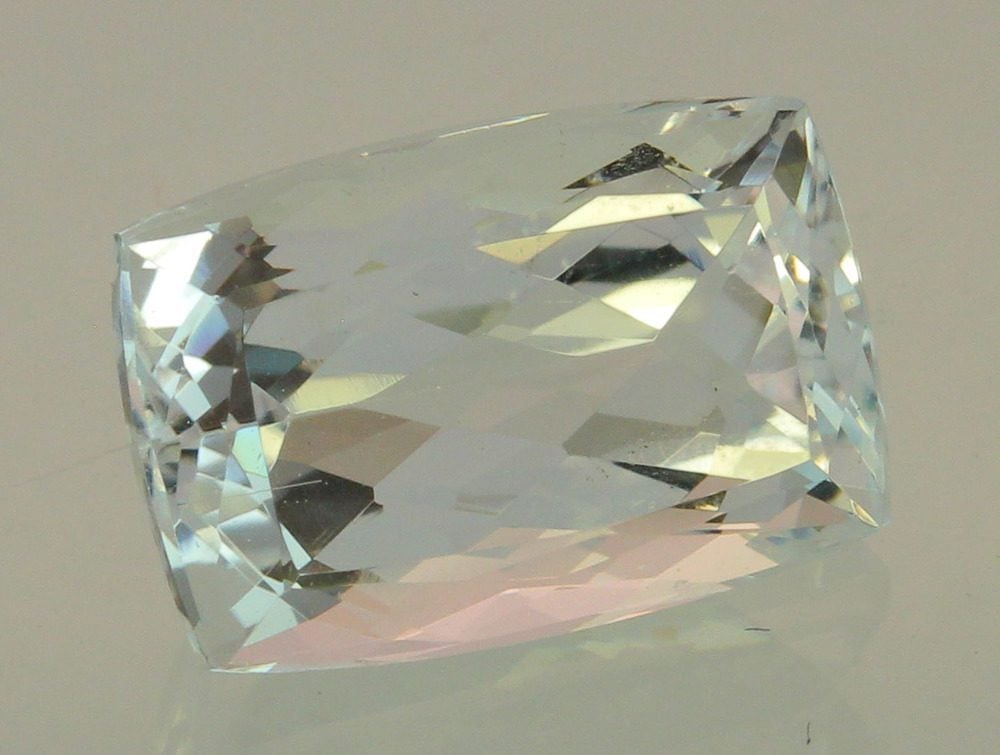Beryllonite Value, Price, and Jewelry Information
Difficult to facet and typically colorless, beryllonite is a rare collector’s gem. Some specimens can show a striking cat’s eye.
1 Minute Read
Difficult to facet and typically colorless, beryllonite is a rare collector’s gem. Some specimens can show a striking cat’s eye.
Start an IGS Membership today
for full access to our price guide (updated monthly).Beryllonite Value
Comments
Beryllonites aren't really suited for jewelry use. With both perfect and good directions of cleavage, they're difficult to cut. Typically colorless or pale yellow and with little dispersion, their low refractive index also means they lack brilliance. Their hardness falls below the mark that would make them durable enough for everyday wear.
Nevertheless, beryllonite's rarity makes any crystal a valued specimen for a collector, and faceted pieces are especially prized. Long known only from Maine, a few new sources have been discovered but haven't yielded too much facetable material. However, beryllonites from Afghanistan can sometimes show chatoyancy when cabbed properly. This cat's eye effect is caused by the formation of inclusions of parallel tubes.
Please note, despite its name, beryllonite doesn't belong to the beryl species. Although both contain the rare element beryllium, these gems have different chemical formulas and crystal systems.
Synthetics
Scientists have synthesized beryllonites, and while they may seem unlikely choices, synthetic beryllonites have indeed appeared in jewelry.
Enhancements
No known gemstone treatments or enhancements.
Sources
Stoneham, Maine, the type locality, produces cuttable crystals as well as crystalline masses up to 1-2 inches. However, only small, clean areas within such masses could be cut.
Newry, Maine produces opaque white crystals, not really cuttable.
Other notable sources of gem-quality material include the following:
- Afghanistan, Brazil, Pakistan.
Stone Sizes
Usually only available as small, colorless stones, most gems weigh less than 5 carats. Stones up to 10 carats have been cut, but their clarity isn't clean. As a mineral, beryllonite is rare and very few gems are known.
All the gems listed below came from Maine.
- Smithsonian Institution (Washington, DC): 2.5, 3.3, 3.9, 5.10.
- Devonian Group (Calgary, Alberta, Canada): 5.70.
- Harvard University: 6.22.
- Private Collection: 7.82, 8.77, 4.32.
Care
Since beryllonites may contain liquid inclusions, don't use mechanical systems to clean them. Use only water, mild detergent, and a soft brush. Avoid any cleaner that contains acid, since these gems are soluble in acid.
Use protective settings for beryllonites, especially for ring use, or reserve them for occasional wear.
For more care recommendations, consult our gemstone jewelry cleaning guide.
Joel E. Arem, Ph.D., FGA
Dr. Joel E. Arem has more than 60 years of experience in the world of gems and minerals. After obtaining his Ph.D. in Mineralogy from Harvard University, he has published numerous books that are still among the most widely used references and guidebooks on crystals, gems and minerals in the world.
Co-founder and President of numerous organizations, Dr. Arem has enjoyed a lifelong career in mineralogy and gemology. He has been a Smithsonian scientist and Curator, a consultant to many well-known companies and institutions, and a prolific author and speaker. Although his main activities have been as a gem cutter and dealer, his focus has always been education. joelarem.com
International Gem Society
Related Articles
Black Diamond Value, Price, and Jewelry Information
Chameleon Diamond Value, Price, and Jewelry Information
Gray Diamond Value, Price, and Jewelry Information
Green Diamond Value, Price, and Jewelry Information
Latest Articles
800 Years of Mogok: A Celebration in Tenuous Times
What is the Average Gemstone Faceting Yield?
Pyroxmangite Value, Price, and Jewelry Information
How to Identify Emerald Simulants and Synthetics
Never Stop Learning
When you join the IGS community, you get trusted diamond & gemstone information when you need it.
Get Gemology Insights
Get started with the International Gem Society’s free guide to gemstone identification. Join our weekly newsletter & get a free copy of the Gem ID Checklist!
